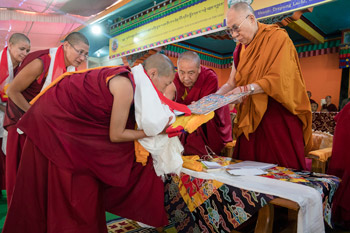On a momentous day for Buddhism, 20 Tibetan nuns have received their Geshema qualification – the first to do so in history.
The degree is the highest academic feat in Tibetan Buddhism and involves at least a decade of rigorous philosophical study. For centuries, it has been possible only for monks, a surprising tenet in a religion otherwise widely deemed to be progressive.
His Holiness the Dalai Lama had long sought to abandon this rule, but it required the consent of the entire community of Tibetan religious leaders. In 2012, marking a new chapter in the empowerment of Tibetan women, the decision to give them equal educational rights to men was finally made.
These nuns are the first to conclude their studies and His Holiness presided over the historic event at Drepung Monastery in south India. It coincided with the 600th anniversary of the religious institution.
During the ceremony, His Holiness spoke about how important education is for gender equality across the globe and emphasised the need for modern education to focus more on ethics, stating:
“Through the power of education, women have been able to rise up to prominent roles including leadership in various societies. Education has played a big role in the advancement of gender equality and material development. However, when you think about secular ethics like compassion, modern education is still not sufficient.”
He had previously declared that the move to allow women to reach the same educational heights as men was his contribution to the advancement of Buddhist Dharma.
This historic event was just one element of the spiritual leader’s 13 day round trip, beginning and ending in the Indian capital. Arriving on December 14, his time in Delhi was brief but busy. He gave several talks, the first of which was an interview with Kailash Satyarthi, founder of the Kailash Satyarthi Children’s Foundation and co-winner of the 2014 Nobel Peace Prize.
His Holiness declared her work wonderful, saying: “Every child should be free to be a child…If the 21st century is to be different those who are children today must make the effort to create a more peaceful, compassionate world.”
He was the guest of honour at the 5th annual convocation of Ambedkar University, and spoke at the 50th anniversary of Tibet House. The event also marked 100 years since the founding of the medical and astrological institute, Men-tsee-khang and the celebration included prayers, dances and readings.
It was then onwards to Bengaluru, where His Holiness inaugurated a new academic building at the Dalai Lama Institute for Higher Studies before flying on to a wet and windy Mysuru.
There, the spiritual leader attended The University of Mysore’s 97th convocation where he stated: “I am happy and honoured to participate in this ceremony at one of the country’s oldest universities. I have a special link and a fondness for Karnataka which goes back to Nijalingappa’s friendship and generosity to Tibetans.”
Next stop was Mundgod and on December 18, His Holiness stood before 3000 monks, 260 nuns – including the 20 new Geshemas – hundreds of local Tibetan children and many foreigners for the first international Emory Tibet Symposium.
The debate addressed how science and Buddhism could complement each other and comes as a result of the Dalai Lama’s desire for dialogue between the two disciplines. Over the years, a close relationship has developed between Emory University and the Library of Tibetan Works & Archives, culminating in this important event.
Before flying home, from December 25 – 27, the Tibetan spiritual leader will give teachings on Shantideva’s A guide to Bodhisattva’s Way of Life for a Russian group in Delhi.






 Print
Print Email
Email